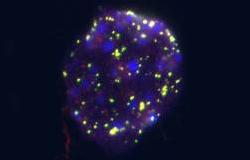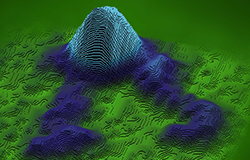About our lab
Our research
Our Lab is headed by Roland Kanaar, head of the Erasmus MC department of Molecular Genetics.
Our research team pursues three integrated lines of research:
- Mechanisms of the DNA damage response
- The impact and application of the DNA damage response in cancer
- The impact and application of the DNA damage response in aging - towards intervention strategies for diseases associated with aging-related symptoms

1. Mechanisms of the DNA damage response
This research line addresses the fundamental mechanistic aspects of the DNA damage response, with special attention to DNA repair by homologous recombination. We take complementary and interwoven approaches at both the molecular and cellular level.
The molecular mechanisms of the multiple pathways of the DNA damage response are studied by applying and developing (single molecule) biochemical analyses, advanced proteomic analyses and state-of-the-art molecular imaging techniques to identify dynamic molecular interactions that are responsible for the assembly and disassembly of the molecular factories that guard and repair the genome.
2. The impact and application of the DNA damage response in cancer
Many important anti-cancer treatments are based on the cell killing properties of DNA-damaging agents. The efficacy of such treatments depends on characteristics of the DNA damage response in tumor cells, which is almost invariably compromised and can be exploited to develop better patient selection methods, to guide targeted cancer treatments and to design novel precision cancer treatments.
3. The impact and application of the DNA damage response in aging - towards intervention strategies for diseases associated with aging-related symptoms
The problem of DNA damage not only fosters mutagenesis and thereby carcinogenesis, it also constitutes a major cause of cellular dysfunction, cell death and cellular senescence, driving the process of aging.
Our projects
Key Publications
Kanaar, R., Van de Putte, P. and Cozzarelli, N.R. (1989). Gin-mediated recombination of catenated and knotted DNA substrates: Implications for the mechanism of interaction between cis-acting sites. Cell 58, 147-159.
Kanaar, R., Klippel, A., Shekhtman, E., Dungan, J.M., Kahmann, R. and Cozzarelli, N.R. (1990). Processive recombination by the phage Mu Gin system: Implications for mechanisms of DNA strand exchange, DNA site alignment, and enhancer action. Cell 62, 353-366.
Kanaar, R., Roche, S.E., Beall, E.L., Green, M.R. and Rio, D.C. (1993). The conserved pre-mRNA splicing factor U2AF from Drosophila: Requirement for viability. Science 262, 569-573.
Kanaar, R., Troelstra, C., Swagemakers, S., Essers, J., Smit, B., Franssen, J.-H., Pastink, A., Bezzubova, O., Buerstedde, J.-M., Clever, B., Heyer, W.-D. and Hoeijmakers, J.H.J. (1996). Human and mouse homologs of the Saccharomyces cerevisiae RAD54 DNA repair gene: Evidence for functional conservation. Curr. Biol. 6, 828-838.
Essers, J., Hendriks, R.W., Swagemakers, S.M.A., Troelstra, C., de Wit, J., Bootsma, D., Hoeijmakers, J.H.J. and Kanaar, R. (1997). Disruption of mouse RAD54 reduces ionizing radiation resistance and homologous recombination. Cell 89, 195-204.
Essers, J., van Steeg, H., de Wit, J., Swagemakers, S.M.A., Vermeij, M., Hoeijmakers, J.H.J. and Kanaar, R. (2000). Homologous and non-homologous recombination differentially affect DNA damage repair in mice. EMBO J. 19, 1703-1710.
Van Gent, D.C., Hoeijmakers, J.H.J. and Kanaar, R. (2001). Chromosomal stability and the DNA double-stranded break connection. Nat. Rev. Genet. 2, 196-206.
Ristic, D., Wyman, C., Paulusma, C. and Kanaar, R. (2001). The architecture of the human Rad54-DNA complex provides evidence for protein translocation along DNA. Proc. Natl. Acad. Sci. USA 98, 8454-8460.
De Jager, M., van Noort, J., van Gent, D.C., Dekker, C., Kanaar, R. and Wyman, C. (2001). Human Rad50/Mre11 is a flexible complex that can tether DNA ends. Mol. Cell 8, 1129-1135.
Essers, J., Houtsmuller, A.B., van Veelen, L., Paulusma, C., Nigg, A.L., Pastink, A., Vermeulen, W., Hoeijmakers, J.H.J. and Kanaar, R. (2002). Nuclear dynamics of RAD52 group homologous recombination proteins in response to DNA damage. EMBO J. 21, 2030-2037.
Aten, J.A., Stap, J., Krawczyk, P.M., van Oven, C.H., Hoebe, R.A., Essers, J. and Kanaar, R. (2004). Dynamics of DNA double-strand breaks revealed by clustering of damaged chromosome domains. Science 303, 92-95.
Niedernhofer, L.J., Odijk, H., Budzowska, M., van Drunen, E., Maas, A., Theil, A.F., de Wit, J., Jaspers, N.G.J., Beverloo, H.B., Hoeijmakers, J.H.J. and Kanaar, R. (2004). The structure-specific endonuclease Ercc1-Xpf is required to resolve DNA interstrand crosslink-induced double-strand breaks. Mol. Cell. Biol. 24, 5776-5787.
Essers, J., van Cappellen, W.A., Theil, A.F., van Drunen, E., Jaspers, N.G., Hoeijmakers, J.H., Wyman, C., Vermeulen, W. and Kanaar, R. (2005). Dynamics of relative chromosome position during the cell cycle. Mol. Biol. Cell 16, 769-775.
Moreno-Herrero, F., de Jager, M., Dekker, N.H., Kanaar, R., Wyman, C. and Dekker, C. (2005). Mesoscale conformational changes in the DNA repair complex Rad50/Mre11/Nbs1 upon DNA binding. Nature 437, 440-443.
Wesoly, J., Agarwal, S., Sigurdsson, S., Bussen, W., Van Komen, S., Qin, J., Van Steeg, H., Van Benthem, J., Wassenaar, E., Baarends, W.M., Ghazvini, M., Tafel, A.A., Heath, H., Galjart, N., Essers, J., Grootegoed, J.A., Arnheim, N., Bezzubova, O., Buerstedde, J.M., Sung, P. and Kanaar, R. (2006). Differential contributions of mammalian Rad54 paralogs to recombination, DNA damage repair and meiosis. Mol. Cell. Biol. 26, 976-989.
Wyman, C. and Kanaar, R. (2006). DNA double-strand break repair: All’s well that ends well. Ann. Rev. Genet. 40, 363-383.
Hanada, K., Budzowska, M., Modesti, M., Maas, A., Wyman, C., Essers, J. and Kanaar, R. (2006). The structure-specific endonuclease Mus81-Eme1 promotes conversion of interstrand DNA cross-links into double-strands breaks. EMBO J. 25, 4921-4932.
Modesti, M., Ristic, D., van der Heijden, T. Dekker, C., van Mameren, J., Peterman, E.J., Wuite, G.J., Kanaar, R. and Wyman, C. (2007). Fluorescent human Rad51 reveals multiple nucleation sites and filament segments tightly associated along a single DNA molecule. Structure 15, 599-609.
Hanada, K., Budzowska, M., Davies, S.L., van Drunen, E., Beverloo, B.H., Maas, A., Essers, J., Hickson, I.D. and Kanaar, R. (2007). The structure-specific endonuclease Mus81-Eme1 contributes to replication restart by generating double-strand DNA breaks. Nat. Struct. Mol. Biol. 14, 1096-1104.
Modesti, M., Budzowska, M., Baldeyron, C., Demmers, J.A., Ghirlando, R. and Kanaar, R. (2007). RAD51AP1 is a structure-specific DNA binding protein that stimulates joint molecule formation during RAD51-mediated homologous recombination. Mol. Cell 28, 468-481.
van Mameren, J., Modesti, M., Kanaar, R., Wyman, C., Peterman, E. J. and Wuite, G. J. (2009). Counting RAD51 proteins disassembling from nucleoprotein filaments under tension. Nature 457, 745-748.
Agarwal, S., van Cappellen, W.A., Guénolé, A., Eppink, B., Linsen, S.E.V., Meijering, E., Houtsmuller, A., Kanaar*, R. and Essers, J. (2011). ATP-dependent and ATP-independent functions of Rad54 in genome maintenance. J. Cell Biol. 192, 735-750. *corresponding author
Krawczyk, P.M., Eppink, B., Essers, J., Stap, J., Rodermond, H., Odijk, H., Zelensky, A., van Bree, C., Stalpers, L.J., Buist, M.R., Soullié, T., Rens, J., Verhagen, H.J., O'Connor, M.J., Franken, N.A., Ten Hagen, T.L., Kanaar*, R. and Aten, J.A. (2011). Mild hyperthermia inhibits homologous recombination, induces BRCA2 degradation, and sensitizes cancer cells to poly (ADP-ribose) polymerase-1 inhibition. Proc. Natl. Acad. Sci. USA 108, 9851-9856. *corresponding author
Tham, K.C., Hermans, K., Winterwerp, H., Cox, M.M., Wyman, C., Kanaar, R. and Lebbink, J. (2013). Mismatch repair inhibits homeologous recombination by coordinating directional unwinding of trapped DNA structures. Mol. Cell 51, 326-337.
Naipal, K.A., Verkaik, N.S., Ameziane, N., van Deurzen, C.H., Ter Brugge, P., Meijers, M., Sieuwerts, A.M., Martens, J., O'Connor, M.J., Vrieling, H., Hoeijmakers, J.H., Jonkers, J., Kanaar, R., de Winter, J., Vreeswijk, M., Jager, A. and van Gent, D.C. (2014). Functional ex vivo assay to select homologus recombination deficient breast tumors for PARP inhibitor treatment. Clin. Cancer Res. 20, 4816-4826.
Reuter, M., Zelensky, A., Smal, I., Meijering, E., van Cappellen, W.A., de Gruiter, M.H., van Belle, G.J., van Royen, M.E., Houtsmuller, A.B., Essers, J., Kanaar, R. and Wyman, C. (2014). BRCA2 diffuses as oligomeric clusters with RAD51 and changes mobility after DNA damage in live cells. J. Cell Biol. 207, 599-613.
Ameziane, N., May, P., Haitjema, A., Van de Vrugt, H.J., Van Rossum-Fikkert, S.E., Ristic, D., Williams, G.J., Balk, J., Rockx, D., Li, H., Rooimans, M.A., Oostra, A.B., Velleuer, E., Dietrich, R., Bleijerveld, O.B., Altelaar, A.F.M., Meijers-Heijboer, H., Joenje, H., Glusman, G., Roach, J., Hood, L., Galas, D., Wyman, C., Balling, R., den Dunnen, J., De Winter, J.P., Kanaar, R., Gelinas, R. and Dorsman, J.C. (2015). A novel Fanconi anemia subtype associated with a dominant-negative mutation in RAD51. Nature Comm. 6, 8829.
Naipal, K.A., Verkaik, N.S., Sánchez, H., van Deurzen, C.H., den Bakker, M.A., Hoeijmakers, J.H., Kanaar, R., Vreeswijk, M.P., Jager, A. and van Gent, D.C. (2016). Tumor slice culture system to assess drug response of primary breast cancer. BMC Cancer 16, 78.


